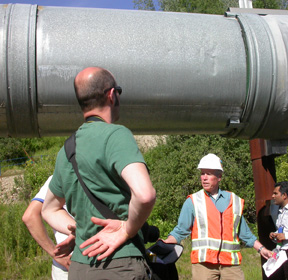The greatest story of man and permafrost
January 4, 2012

907-474-7468
1-4-12
In 1973, Elden Johnson was a young engineer with a job working on one of the most ambitious and uncertain projects in the world — an 800-mile steel pipeline that carried warm oil over frozen ground. Thirty-five years later, Johnson looked back at what he called “the greatest story ever told of man’s interaction with permafrost.”
The four-foot in diameter, half-inch-thick steel pipe had an original design lifespan of 30 years. The state of Alaska and the U.S. Department of the Interior not long ago the pipeline the green light for another 30 years of operation.
“It’s like a car,” said Johnson, who worked for Alyeska Pipeline Service Company for many years and now works for BP Exploration Alaska. “As long as you maintain it, it’ll continue to work.”
Permafrost, frozen ground that is a relic of the last ice age, exists beneath about 75 percent of the pipeline’s 800-mile route. When ice-rich permafrost thaws, the ground slumps, causing problems for structures above.
After the 1969 oil discovery at Prudhoe Bay, developers unfamiliar with Alaska wanted to bury the entire supply of Japanese-made pipe. But after a review by people who knew of the dangers of building on permafrost, a legion of workers constructed a pipeline that they buried for 380 miles and — in areas of permafrost — built above the ground on platforms for 420 miles.
The initial design was good, but not perfect, Johnson said. He remembered during construction when he and others were inspecting the ground from the Yukon River to Coldfoot, found unstable permafrost, and recommended that sections of the pipeline be re-designed. Instead of conventional buried pipeline, the engineers called for more-expensive and time-consumptive aboveground pipeline.
“We changed the design for at least 20 percent of that distance,” he said. “They were gut-wrenching decisions potentially impacting the startup schedule.”
The call to elevate more than half of the pipeline turned out to be a good one. Even though engineers bored holes in the ground about every 800 feet to check for permafrost, they didn’t find it all. When the pipeline was two years old in 1979, the pipe buckled and leaked in two buried sections because of thawed permafrost. In both cases, the pipeline, which carried oil that left the ground in Prudhoe Bay as warm as 145 degrees F, caused about four feet of settlement. Engineers fixed those and other problems, and the two leaks in 1979 are still the only spills caused by permafrost.
Alyeska Pipeline Service Co. workers check the pipeline each year for signs of settling and proper operation of the heat pipes that help keep the support posts of the above-ground pipeline anchored in frozen ground. The buried pipeline has in 31 years become more stable as the more rapid thawing of early years has settled down.
“The risk to the buried pipeline right now is becoming minimal,” Johnson said.
The pipeline has delivered more than 16 billion barrels of oil since its startup in June 1977, with two brief shutdowns due to permafrost problems.
Johnson estimated permafrost-related maintenance has totaled about 5-to-10 percent of the operating costs over the life of the pipeline. “It’s the cost of doing business in the Arctic,” he said.
This column is provided as a public service by the Geophysical Institute, University of Alaska Fairbanks, in cooperation with the UAF research community. Ned Rozell is a science writer at the institute. This column first appeared in 2008.


